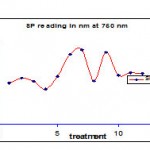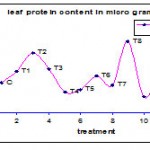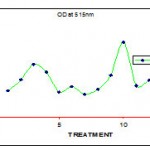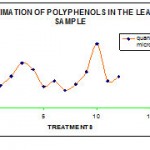How to Cite | Publication History | PlumX Article Matrix
Leaf Protein Estimation of Benzolive Tree by Using Different Bioinoc4ulants and Fertilizers
A. R. Rout1, S. C. Kheti1*, T. Mohapatra1 and A. Tripathy2
1Mahatma Gandhi College of Pharmaceutical Science, Jaipur, Rajasthan India.
2Apex College of Pharmaceutical Science, Jaipur, Rajasthan India.
ABSTRACT: The concept of protein estimation analysis has highly effective on the study of plant reaction in environmental condition. The determination of quantitative protein analysis of plant will vary according to the environmental factors and nutrient application in form of fertilizer and bio-inoculants. The following study specifies the characterization of plant Benzolive tree (Moringa oleifera) PKM1 variety by estimating protein and polyphenol from leaf sample with standardization of Bovine Serum Albumin (BSA) and Gallic acid respectively.
KEYWORDS: Polyphenol; protein; BSA and gallic acid
Download this article as:| Copy the following to cite this article: Rout A. R, Kheti S. C, Mohapatra T, Tripathy A. Leaf Protein Estimation of Benzolive Tree by Using Different Bioinoc4ulants and Fertilizers. Biosci Biotechnol Res Asia 2009;6(1) |
| Copy the following to cite this URL: Rout A. R, Kheti S. C, Mohapatra T, Tripathy A. Leaf Protein Estimation of Benzolive Tree by Using Different Bioinoc4ulants and Fertilizers. Biosci Biotechnol Res Asia 2009;6(1). Biosci Biotechnol Res Asia 2009;6(1) . Available from: https://www.biotech-asia.org/?p=8458 |
Introduction
Moringa oleifera (Benzolive tree) is the most cultivated species of a monogeneric family, Moringaceae native to the Sub–Himalayan tracks of India. Recently there is highly demand of some of the hybrid varieties of Moringa, especially variety PKM1 (South Indian origin) has great effect on protein analysis. The present study is to access the effect of different bio-inoculants and fertilizers on the growth and development of Moringa oleifera (PKM1) variety under green house condition as a part of rural livelihood support and also for the quantitative analysis of protein and the estimation of polyphenol in the leaf sample. 2
Material and Methods
Moringa oleifera PKM1 variety was used as the sample, the experiment set up was done inside the green house maintaining the temperature 27-280C and water was sprayed inside it. The experimental setup contains 2 trays, each of 48 small pots from the total of 96. The pots were filled with sterilized soil and sand through the entire surface area of each pot. Then the row marked as treatments and columns as replication. There were 12 treatments including control containing 8 replications each. Different fertilizers were added to the respective treatments one by one as per the quantity fixed above. There after water was sprayed & then the seeds sowing inside pot i.e one seed per pot.
Then the leaf sample was collected and protein estimation in the sample was carried out by the following method. Standard curve was plotted by taking various concentrations of Bovine Serum Albumin (BSA) Vs absorbance at 750nm and protein content was calculated by taking the absorbance from the graph. Here sample prepared by using the reagent (1ml of 1%CuSO4+1ml 2% sodium potassium tartarate + 48ml of 2%Na2CO3) 4ml + 1ml leaf sample, then allowed to stand for 10min by adding 0.5ml folin phenol and put for another30min. Then OD was taken at 750nm.
Quantitative Estimation of Polyphenols in the leaf sample
The leaf samples were collected and polyphenol estimation in the sample was carried out by the following method. Standard curve was plotted by taking various concentrations of sample in Gallic acid solution Vs absorbance at 515nm and polyphenol content was calculated by taking the absorbance from the graph. Here reagent used for sample preparation is 0.1N HCl, solution of (10% sodium nitrite: 10% sodium molybdate =1:1), 1N NaOH, Gallic acid & 60% methanol.
 |
Figure 1
|
 |
Figure 2
|
 |
Figure 3
|
 |
Figure 4
|
Result and Discussion
Quantitative analysis of protein presents in the leaf sample of Moringa oleifera PKM1 variety was carried out following Lowry method, taking BSA as standard. The concentration of total protein was calculated from the standard curve and amount of protein present in 5ml of the leaf of 12 different treatments were calculated.The treatment T8 in which Fungi is applied contains maximum amount of protein i.e 77microgm/ml.
In the estimation of polyphenols the analysis shows the result that Treatment T9 with Fungi +SSP gives maximum amount of polyphenols i.e 2.87.
So the present study reveals that application of bio-inoculants affects the synthesis of comparatively more protein contents and other metabolites. So utilization of bio-inoculants along with other fertilizers may be justified enough for better yield of Moringa oleifera PKM1 variety.
Table 1: Estimation of leaf protein at 750nm.
| Treatment | SP Reading in nm | protein content in µg/5ml |
| C | 0.4011 | 32.5 |
| T1 | 0.4497 | 45 |
| T2 | 0.4174 | 65 |
| T3 | 0.3407 | 47.5 |
| T4 | 0.464 | 22.5 |
| T5 | 0.6823 | 25 |
| T6 | 0.7229 | 40 |
| T7 | 0.4219 | 30 |
| T8 | 0.7022 | 77.5 |
| T9 | 0.4766 | 17.5 |
| T10 | 0.5003 | 35 |
| T11 | 0.4916 | 15 |
Table 2: Graph for polyphenol estimation.
| Estimation of poly phenols(PP) in leaf sample | ||
| Treatments | OD at 515nm | Quantity of PP in μg/ml |
| C | 0.44 | 53.75 |
| T1 | 0.62 | 77.5 |
| T2 | 0.88 | 110 |
| T3 | 0.75 | 93.75 |
| T4 | 0.42 | 52.5 |
| T5 | 0.51 | 65 |
| T6 | 0.38 | 42.25 |
| T7 | 0.46 | 57.5 |
| T8 | 0.7 | 87.5 |
| T9 | 1.25 | 156.25 |
| T10 | 0.52 | 65 |
| T11 | 0.61 | 76 |
Reference
- Basak, U.C, AB Das and P. Das (in 1998) seasonal changes in organic constituents in leaves of 9th Mangroves species.
- Basak, U.C, AB Das and P. Das (in 1996), chlorophylls carotinoeds proteins and secondary metabolites in leaves of mangroves species of Orissa, bulletin of marine sciences 58 (3) 654-659.
- Lowry, O.H.N.J rosebrough , AL fan & R.J. randall , 1951. protein measurement with the folin phenol reagent, J.boil chem..,193:265-275.
- Dahot MU, SA Ali, et al.(1985) proteolytic enzyme of Moringa oleifera seeds. Journal of pharmacy 6(1-2):1-10.
- Dhar B, and OP Gupta (1982) Nutritional value of Shigru (Moringa oleifera Lam.) B.M.E.B.E.R 3(2-4) 280-288.
- Mishra (1993) Drumstick polysaccharide as pharmaceutical adjuvant. Indian Journal of Natural Products 9(1): 3-6.

This work is licensed under a Creative Commons Attribution 4.0 International License.





